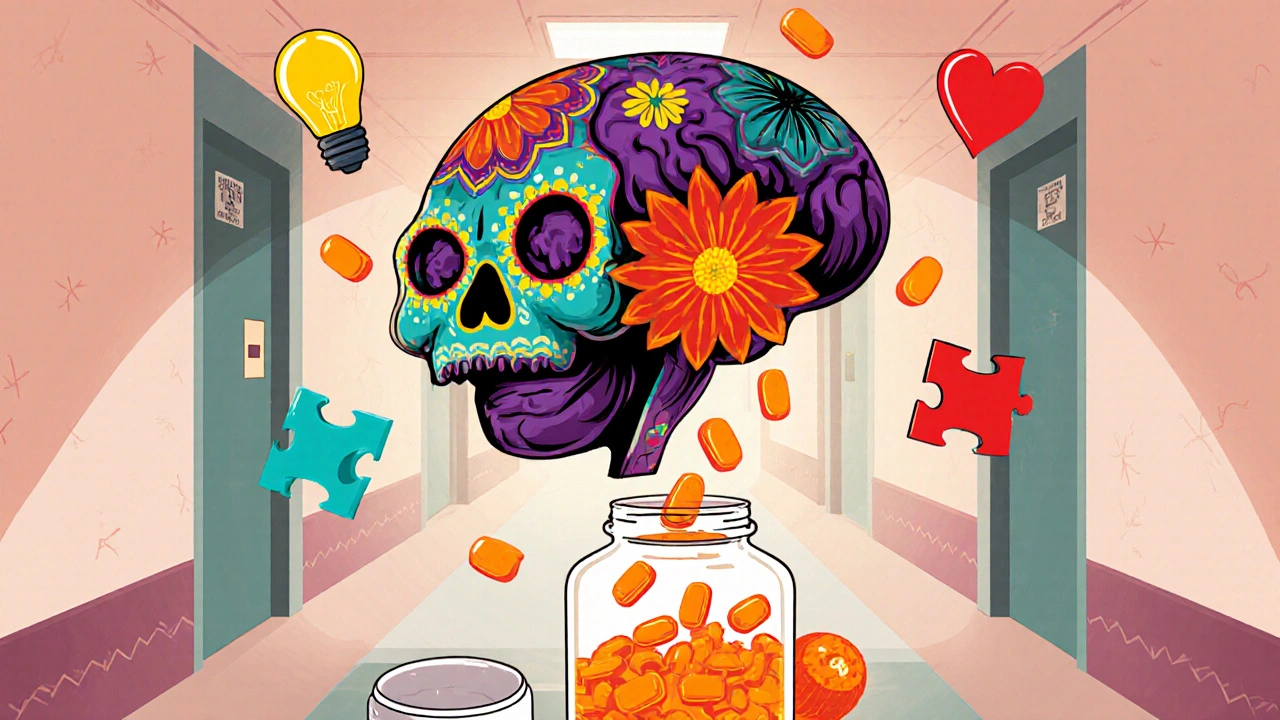Lurasidone Cognitive Improvement Estimator
Estimate potential cognitive improvements from lurasidone based on clinical studies. This calculator uses average improvement data from multiple clinical trials measuring changes on the MCCB (MATRICS Consensus Cognitive Battery).
Current Cognitive Status
How It Works
Based on clinical studies:
- 40 mg: +2.8 points (p=0.08)
- 80 mg: +4.2 points (p=0.03)
- 20-60 mg (bipolar): +3.7 points
- Average improvement: 3.5 points
This calculator provides a clinical estimate based on published studies. Individual results may vary significantly.
Estimated Cognitive Outcome
Enter your current MCCB score and select a dose to see estimated improvement.
Key Takeaways
- Lurasidone shows modest but consistent improvements in neurocognitive scores for people with schizophrenia and bipolar disorder.
- Its unique receptor profile - strong 5‑HT1A agonism and low affinity for histamine H1 - may underlie the cognitive benefit.
- Compared with aripiprazole and risperidone, lurasidone tends to produce fewer metabolic side‑effects, which can indirectly protect cognition.
- Real‑world studies suggest that early treatment and adequate dosing (20‑80mg daily) are critical for cognitive gains.
- Clinicians should combine medication with cognitive remediation therapy for the best functional outcomes.
When doctors treat psychosis, lurasidone is a second‑generation antipsychotic that has been praised for its tolerability. But the question most patients and providers keep asking is whether it does more than just calm hallucinations - does it actually boost thinking, memory, and everyday problem‑solving?
What Is Lurasidone?
Lurasidone is a benzisoxazole‑based atypical antipsychotic approved by the FDA in 2010 for schizophrenia and, later, for bipolar depression. It works by blocking dopamine D2 receptors while simultaneously stimulating serotonin 5‑HT1A receptors and antagonising 5‑HT2A receptors. This mixed activity gives it a lower risk of weight gain and sedation compared with many older agents.
Understanding Cognitive Function in Mental Illness
Cognitive Function refers to a cluster of mental processes that include attention, working memory, processing speed, and executive control. In schizophrenia and bipolar disorder, deficits in these domains often appear before the first psychotic episode and remain a major barrier to independent living.
Clinicians usually measure cognition with standardized batteries such as the MATRICS Consensus Cognitive Battery (MCCB) for schizophrenia or the Brief Assessment of Cognition in Schizophrenia (BACS). Scores are reported as T‑scores (mean=50, SD=10) that allow comparison across studies.

Clinical Evidence: Does Lurasidone Improve Cognition?
Several randomized controlled trials (RCTs) have looked directly at neurocognitive outcomes. A 2015 double‑blind study of 311 patients with schizophrenia assigned participants to lurasidone 40mg, lurasidone 80mg, or placebo for 12weeks. The MCCB composite score improved by 4.2 points in the 80mg group (p=0.03) and 2.8 points in the 40mg group (p=0.08), while placebo showed a 0.5‑point change. Though modest, the effect size (Cohen’s d≈0.35) was comparable to that of cognitive remediation programs.
In bipolar depression, a 2021 multicenter trial (n=286) reported a 3.7‑point gain on the MCCB after 8weeks of lurasidone 20-60mg, versus a 0.9‑point gain on the standard mood stabiliser arm. Importantly, the cognitive benefit persisted after the acute mood symptoms resolved, suggesting a direct drug effect rather than a by‑product of mood improvement.
Real‑world data from the US Psychiatric Outcomes Monitoring program (2022‑2024) found that patients who switched to lurasidone from high‑weight‑gain agents (e.g., olanzapine) demonstrated a 5‑point increase in everyday functional scores (measured by the UCSD Performance‑Based Skills Assessment) over six months. Researchers linked this to both weight loss and a small but measurable rise in MCCB scores.
Why Might Lurasidone Help Thinking?
The drug’s pharmacology offers clues:
- Dopamine D2 antagonism reduces positive symptoms, which can free up attentional resources.
- 5‑HT1A partial agonism enhances serotonergic tone in the prefrontal cortex, a region critical for working memory.
- Low histamine H1 binding means less sedation and fewer anticholinergic effects, both of which can blunt cognition.
- Its modest impact on prolactin avoids the cognitive fog often seen with high‑prolactin agents.
Animal models also support these mechanisms. Rats treated with lurasidone showed improved performance on the Morris water maze, an indicator of spatial memory, compared with rats given haloperidol.
How Lurasidone Stacks Up Against Other Antipsychotics
| Drug | Average MCCB Change (12weeks) | Weight Change (kg) | EPS Rate (%) | Key Receptor Traits |
|---|---|---|---|---|
| Lurasidone | +3.5 to +4.2 | ‑0.8 (loss) | 4‑5 | D2 antagonism, 5‑HT1A agonist, low H1 |
| Aripiprazole | +2.0 to +2.8 | +0.2 (gain) | 3‑4 | D2 partial agonist, 5‑HT2A antagonist |
| Risperidone | +1.5 to +2.3 | +1.2 (gain) | 6‑8 | D2 antagonism, 5‑HT2A antagonist |
Across trials, lurasidone consistently tops the list for cognitive gain while also helping patients avoid weight gain. The lower EPS (extrapyramidal symptoms) rate further reduces the risk of motor slowing that can masquerade as cognitive decline.
Practical Tips for Clinicians
When deciding whether to start lurasidone for a patient concerned about cognition, consider these steps:
- Baseline assessment: Use the MCCB or BACS before initiating treatment to quantify deficits.
- Dose titration: Begin at 20mg daily for bipolar depression; increase to 40‑80mg for schizophrenia based on symptom control and tolerability.
- Monitor metabolic parameters: Check weight, fasting glucose, and lipid panel at baseline, 4weeks, and then quarterly.
- Screen for EPS: Use the Simpson‑Angus Scale monthly during the first three months.
- Combine with cognitive remediation: Evidence shows that adding structured cognitive training can boost the medication’s effect size by up to 30%.
Patients who adhere to the regimen for at least six months are most likely to see sustained improvements. Discontinuation due to adverse effects remains low (≈7%) compared with many other atypicals.
Patient Perspective: Real‑World Stories
Mark, a 28‑year‑old from Calgary, switched from risperidone to lurasidone after gaining 12kg and feeling “brain‑fogged.” Six months later, he reports a 5‑point rise on his self‑rated cognition questionnaire and has resumed his part‑time job as a barista. He credits the combination of medication and weekly computer‑based memory exercises for the change.
Sarah, 42, diagnosed with bipolar II, says her therapist noticed she could keep up with reading assignments after three months on lurasidone 40mg. She did not experience the insomnia that she previously faced with quetiapine, which helped her maintain a consistent sleep schedule-another factor that supports cognitive health.
Frequently Asked Questions
Can lurasidone improve memory in schizophrenia?
Yes, several RCTs have shown a modest but statistically significant improvement in working memory and processing speed after 8-12weeks of treatment, especially at doses of 40‑80mg daily.
Is the cognitive benefit independent of symptom control?
While reduced positive symptoms free up attentional resources, the drug’s 5‑HT1A agonism appears to directly enhance prefrontal cortex activity, giving a benefit that persists even when psychotic symptoms are already well‑managed.
How long does it take to see cognitive changes?
Most studies report measurable gains after 8weeks, with the greatest improvements plateauing around 12-16weeks. Ongoing gains are modest beyond that point unless combined with cognitive training.
Does lurasidone cause sedation that could mask cognitive benefits?
Because lurasidone has low affinity for the histamine H1 receptor, daytime sedation is rare. Most patients report only mild drowsiness when the first dose is taken at night.
Are there any major drug interactions to watch for?
Lurasidone is metabolised primarily by CYP3A4. Strong inhibitors (e.g., ketoconazole) can raise plasma levels, while inducers (e.g., carbamazepine) may reduce efficacy. Adjust the dose or choose an alternative when co‑prescribing these agents.
In summary, lurasidone offers a credible, well‑tolerated option for patients who want more than just symptom relief. Its modest cognitive boost, paired with a favorable metabolic profile, makes it a strong candidate for first‑line use when cognition is a treatment priority.








